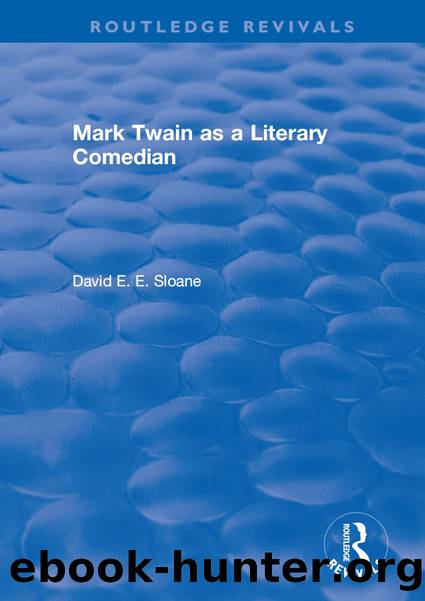Routledge Revivals: Mark Twain As a Literary Comedian (1979) by Sloane David E. E.;

Author:Sloane, David E. E.;
Language: eng
Format: epub
Publisher: Routledge
II
The Adventures of Tom Sawyer bears traces of The Gilded Age and casts further light on it. Humorous material is much more completely subordinated to the boyâs novel themes of the small town. The author is âawareâ of the future gilded age, chronologically, and foreshadows it without directly pointing to its coming. Thus, Tom Sawyer maintains a different mood, considerably more in the vein of local color, from that of The Gilded Age but is not wholly unrelated to it.
As Walter Blair has noted, burlesques of childrenâs novels were written by Max Adeler, T. B. Aldrich, M. Quad, and the Danbury News Man in the 1870s, and their approach seems to have been fairly popular. Shillaberâs Mrs. Partington with her troublesome boy Ike had been well known since the 1850s and was particularly influential on the early descriptions of Aunt Polly in relation to Tom. The structure of the novel emphasizes ârealâ boy traits, however, so the literary tradition must be carefully blended with local setting; burlesque is deemphasized.10 The story is sustained as a narrative stressing alterations of characterâthe sense of milieu which dominates The Gilded Age is now subdued background color. Contemporary reviewers, such as the London Athenaeum, are in agreement with Professor Blairâs findings. Tom Sawyer is seen as âan attempt in a new direction. It is consecutive, and much longer than the former books, and it is not put forward as a mere collection of âscreamersââ11 Scattered literary humor, however, still finds its place in the work.
Tom is brought up, as was Harry Brierly, to be a âheedless ladâ like the rest of his generation of boys (146).12 Coinciding with The Gilded Age, where young men are supposed to be taught to expect easy money by their environment, Tom comes into a large fortune through adventure rather than labor, and is admired by the town. These correspondences are not accidental but rather seem to foreshadow the failures of the coming era; the older era has the seeds of the 1870s within it. The Knobs Industrial College is a swindle disguised as aid for the Negro freedman; in almost unnoticeable foreshadowing, verbal irony appears in Twainâs description of Tom washing dirt off of his face, becoming âa man and a brother, without distinction of colorâ (32). Contemporary readers would have recognized this allusion to one of the most widespread of the English anti-slavery mottoes of the 1830s, dating at least to 1791 in American experience. No corruption is implied, but irony is present. Twainâs use of the phrase is verbal merely, indifferent to the ethics involved. Such low-keyed humor creates the pre-Civil War, pre-Gilded Age milieu underneath the run of boyhood adventures with cats and school-masters and playmates who white-wash fences. Tomâs early likeness to Ike Partington in the episode with the cat and the pain killer (108â109) fixes him clearly in the small-town milieu of the 1850s, with its boyhood pranks and irresponsibility. Yet Tom is otherwise described as representative of his age, particularly in his desire to show off (38).
Download
This site does not store any files on its server. We only index and link to content provided by other sites. Please contact the content providers to delete copyright contents if any and email us, we'll remove relevant links or contents immediately.
Anxious People by Fredrik Backman(1937)
The Last Thing He Told Me by Laura Dave(1928)
The Soulmate Equation by Christina Lauren(1443)
Romancing Mr. Bridgerton (Bridgerton 04) by Julia Quinn(1297)
The Switch by Beth O'Leary(1098)
Solutions and Other Problems by Allie Brosh(1038)
Not a Happy Family by Shari Lapena(1008)
Kiss My Cupcake by Helena Hunting(985)
Mordew by Alex Pheby(971)
This Time Next Year by Sophie Cousens(933)
Slough House by Mick Herron(904)
A Rogue of One's Own by Evie Dunmore(899)
Playing Nice by JP Delaney(876)
Life's Too Short by Abby Jimenez(863)
No One Is Talking About This by Patricia Lockwood(846)
The Mary Shelley Club by Goldy Moldavsky(839)
Quinoterapia by Quino(822)
Twenty After Midnight by Daniel Galera(803)
Squeeze Me: A Novel by Carl Hiaasen(787)
